ESMA’s SFTR Data Quality Indicators: Progress with Limitations

The New Framework
ESMA finalised its 23 SFTR Data Quality Indicators (DQIs) during 2024 and published them last month together with a “Framework for provision of data and follow-up on SFTR data quality issues“. The framework laid out how results of the DQIs are identified and expressed at the EU level, discussed at the Repositories Task Force (RTF) and shared with National Competent Authorities (NCAs) at the entity level.
NCAs are now expected to follow up with the entities and provide feedback to ESMA. ESMA then reviews the feedback and performs a rerun to confirm the issue has been resolved, this is then shared with the RTF with any follow-ups deemed necessary. Given how variable and sporadic SFTR supervision has been across Europe, these are very positive developments.
Understanding the 23 DQIs: Not All Created Equal
Ask an ESMA official and all 155 SFTR reporting fields were created equal, however, I suspect that there is a very different view on the ground in the regulatory reporting oversight offices of the 30 NCAs and two European Supervisory Authorities (ESAs). Under SFTR, predominantly but not exclusively a systemic risk monitoring regulation, trade economics are king.
In summary, while the DQIs will provide the less sophisticated NCAs with a means of challenge their regulated entities in at least a minimal way, for others unfortunately at this stage, they may be little more than a distraction in performing their valuable work in keeping their domestic economies from harm. ie. time spent reviewing ESMA findings and coordinating responses may actually be better placed analysing genuinely systemic issues in that jurisdiction.
Two-Sided Reconciliation Tests (8 DQIs): Eight of the 22 DQIs rely on a fundamental assumption: that SFTR reports are genuinely two-sided. This means both parties have reporting obligations, are in the same jurisdiction, haven’t delegated their reporting, and their data comes from independent sources rather than shared systems. In theory, this creates a true representation of each firm’s books and records. However the reality is very different. These DQIs are flawed because so few reports are genuinely, independently two-sided. Most data ultimately comes from a single source – whether through shared systems, data vendors, or reporting delegation. In our experience, time and time again, two wrongs really do make a wrong when you’re trying to reconcile reports that originated from the same place.
Reporting Discipline Issues (10 DQIs): A further 10 of the DQIs cover essentially SFTR reporting discipline issues rather than material economics. These include the number of rejected reports (NACKs), late reporting, missing variation margin reports on CCP cleared trades, client codes used in place of LEIs, missing issuer LEIs, incorrect reporting counterparty classification x 3, duplicate reports and not updated event dates.
The One with Potential: DQI 11A Anomalies
There is just one SFTR DQI that appears to have the potential to be truly powerful. Unfortunately like many things SFTR, it is rather loosely defined. DQI 11A Anomalies uses statistical approaches to identify abnormal/anomalous values in listed fields but encouragingly, in ratios between relevant fields too. This DQI spans 20 SFTR fields covering repo, securities lending and margin lending across loan values, collateral values, market values, lending fees, haircuts, CCP margins, collateral reuse and cash reinvestment (for securities lending). Arguably this should really be broken down into hundreds of sub and specific DQIs per type of SFT and nature of the test, such that there is a thorough understanding of the parameters and expectations. It would also enable firms to implement these indicators in their own controls frameworks. Unfortunately there are no further details or definition, such that both NCAs and reporting counterparties are left to guess the precise nature of the tests.
The Bigger Picture Problems
Aside from the limited instances of true independent two-sided reporting and an over-emphasis on reporting discipline, many of the tests also focus on the number of reports or instances, not their economic value. Also considering that in terms of market size and risk exposure, in excess of 75% of the SFT market in the EU is repo and the closely related buy-sellback market, it is something of a concern that the lion’s share of DQIs are focused on the securities lending. As primarily macro-systemic regulation, this is disappointing.
Looking Forward
It’s easy to pick holes in the new SFTR DQIs but for the forgotten stepchild of EMIR, they are certainly a move in the right direction. While at this stage it appears to be something of an opportunity squandered, firms should be painfully aware that they are on notice to up their game in terms of SFTR data quality. Those NCAs that have kept quiet and have been lurking in the shadows are highly likely to let their presence be felt once they start receiving DQI queries from ESMA that require their attention.
Kaizen’s quality assurance testing includes checking for all issues included in ESMA’s DQIs and many more. For a conversation with Jonathan or one of our regulatory experts about your SFTR data quality, please get in touch.


